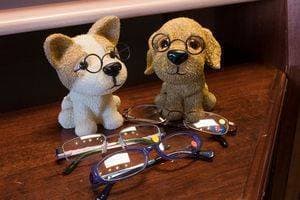What are bifocals?
Bifocals are glasses that contain two lens prescriptions, one for near vision and one for distance vision. The lens powers are usually differentiated by either a bisecting line, or a D-shaped segment.
Why do some children with lazy eye require bifocals?
- Bifocals are generally prescribed to support the child’s focusing system.
- Focusing problems can cause lazy eye.
- Untreated focusing problems can lead to accommodative esotropia (inward eye turn).
Accommodative esotropia
Accommodative esotropia, also called refractive esotropia, is one of the most common forms of esotropia— which is a type of strabismus, or inward eye turn.
- Approximately 2% of the population has accommodative esotropia.
- Accommodative esotropia is most common in children with moderate to high amounts of hyperopia (farsightedness).
Accommodative esotropia occurs when the eyes work to focus on an object for increased clarity of vision. Children with this type of esotropia are typically far-sighted— and unable to see near objects clearly.
The effort that is exerted to focus on an object is called accommodation. When the eyes focus too intently, over-convergence can result— causing the eyes to cross inwards.
Bifocals for lazy eye and accommodative esotropia
When a child with a lazy eye presents with an eye turn towards the child’s nose during near vision tasks, such as reading, accommodative esotropia may be the cause. An eye turn may occur even if a child is wearing glasses for correction of farsightedness.
Bifocals may be beneficial for children with lazy eye and accommodative esotropia as they contain a stronger prescription in the lower area of the lens, the area that is used for near vision tasks.
Bifocals function to relax the focusing effort— preventing the weaker eye from turning inward.
Glasses or contact lenses which are used to treat accommodative esotropia should be worn full time for optimal results.
Infants
Infants are naturally far-sighted and may appear cross-eyed at times. Sometimes this occurs as a result of reduced development of focusing skills that are essential for near vision.
In most cases, these young children may require single-vision glasses. However, if eye crossing persists even with corrective lenses, their prescription may be changed.
While eye crossing will occur when the child is not wearing their glasses, it is important to note that with glasses, there should be no presence of an eye turn.
Why is accommodative esotropia a concern?
If a child’s eyes cross at an early age, then vision in the ‘weaker’ eye may not develop normally.
When vision does not develop normally during childhood, a lazy eye can develop— inhibiting stereopsis or depth perception to develop normally.
When accommodative esotropia is diagnosed and treated at an early age, then vision development will progress normally.
Contact an eye doctor near you to see if bifocals are a good option to manage your child’s lazy eye.
SEE RELATED: Lazy Eye Success
Can bifocals make the eye turn worse?
No.
After a child begins to wear glasses for accommodative esotropia, you may notice that their eyes appear straight when wearing the glasses, but misaligned without the glasses— this is normal.
In some children, the eye turn may even appear to be worse when the glasses are not worn. The goal is to ensure that the eyes are aligned when the child is wearing the glasses— this will ensure that their binocular vision will develop normally.
If you are concerned about your child’s vision and the appearance of eye crossing, inform your eye doctor at your follow up eye exams. These exams are important for monitoring eye crossing, as well as ensuring that a lazy eye does not develop that can cause reduced vision in one or both eyes.
How long will it take for children to get used to bifocals?
It may take several weeks for a child to get used to using their bifocal lenses correctly, as they need to train themselves to use the different areas of the lens appropriately. Parents may notice that their child has developed a change in posture or that they tilt their head as they acclimate to their new vision prescriptions.
Rest assured that your child will adjust on their own to their new bifocal lenses without your help. As a parent, your main concern is to ensure that your child is wearing their glasses full time for optimal treatment results.
Can children outgrow accommodative esotropia?
Yes, but generally only after receiving the right treatment.
Children can outgrow accommodative esotropia, especially if they have received proper eye care, and their focusing ability has improved.
Children usually begin to outgrow this vision condition as they enter grade school and adolescent years, and as the child becomes less farsighted.
Can vision therapy treat accommodative esotropia?
Vision therapy works to strengthen and improve focusing abilities to enhance vision clarity for close objects, and activities such as reading.
Vision therapy builds 3D vision, or stereopsis; by enhancing the vision skills the eye turn is reduced and eye alignment is achieved.
In many cases, vision therapy can facilitate improved eye alignment without the need for surgery. In other cases, vision therapy is prescribed after surgery to help maintain eye alignment, and to improve depth perception necessary for school, sports and driving.
Schedule an appointment with a vision therapy eye doctor to start improving your child’s vision.
Will my child require surgery?
Over 80 percent of children with accommodative esotropia will be treated with glasses or vision therapy, and will not require eye surgery.
Eye-muscle surgery is most often only used for cosmetic reasons, so the eyes appear straight. However, the surgery is not able to correct the underlying problem— the way visual information is processed in the brain. Therefore, proper alignment may not last, and additional surgeries may be required.
Bifocals are typically prescribed for children who need support for their focusing skills.
If your child has been prescribed bifocal lenses, give them time to adjust to their new vision, and do not be alarmed if you notice that their eyes appear straight only when they are wearing their glasses.
To enable optimal results from bifocal use, continue to follow up with your eye doctor on a regular basis, or as recommended. By doing so, your child’s vision will be able to continue to develop normally, and will be clear and comfortable for all vision tasks.
LEARN MORE: Vision Therapy for Lazy Eye
Contact an eye doctor near you who has experience diagnosing and treating lazy eye so that you child can improve their vision.


